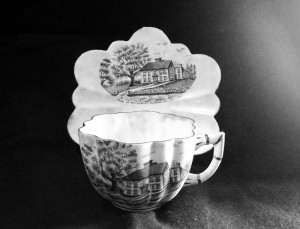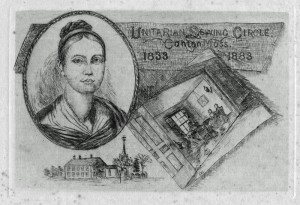True Tales from Canton’s Past: Ladies Sewing Circle
By George T. ComeauIn my hands are several fine pieces of china, remembrances of Canton’s history. Several small white English bone china pieces that have scenes of our history in black etchings. Turning a bowl over, the stamp on the back reads, “Made in England, Unitarian Ladies Sewing Circle.” I have always been drawn to these relics, always looking on eBay. Perhaps you have a piece in your house. It would not be uncommon, but behind these pieces of china is an amazing story of the women of our town who set out to simply “do good.”

A china cup and saucer depicting the home of Parson Dunbar (Courtesy of the Canton Historical Society)
On a frigid January in 1833, the ladies gathered in the home of Reverend Henry Edes, the sixth minister of the First Congregational Parish. There were 42 women that Maria Edes had brought together, and they were the who’s who of Canton women. Names that still ring through our history today: Lincoln, Crane, Downes, Bazin, Dunbar, Davenport and Horton, to name a few. These women came together to form a circle, and the fruits of their work can still be seen today.
Canton was a town that was growing at an alarming rate. Construction was well underway at the Viaduct and at the railroad that would transform the town into an industrial powerhouse. Already, the immigrant base had expanded as a result of the Revere Copper and Rolling Mill, the Stone Factory, and the Kinsley Iron Works. There was much need for charity among the poor, and the wealthy women undertook the challenge by forming the “Working Circle.” Within a year, the group was renamed the “Sewing Circle.”
Inscribed in a woman’s hand is the constitution of the organization: “To supply the want of books in the Sunday school library. Should the society be blessed in their endeavors to relieve this want, and a fund still remain, by a vote of the society it may be appropriated to any benevolent purpose whatever, it being the express object of the society to do good.” It was Mrs. Edes who recognized that as a group the women could bring sewing work and sell the items to raise funds for purchasing books for the library. The first books to start off the organization were donated by the Canton Lyceum, and in time the Sewing Circle’s books would help start the Canton Public Library.
In the first year of the organization the women donated cloth, stockings, caps, shoes and aprons. It was the start of something big. On June 2, 1835, the first Sewing Circle Fair was held at Mr. Leonard Everett’s Hall. Over 800 articles were sold along with plentiful amounts of cakes and confections. The sale was an enormous success, netting $244, which in today’s dollars would have the purchasing equivalent of over $7,000.
The society grew, and so too did their ambitions. The ladies met frequently, at first at each other’s homes and eventually moving to larger accommodations at Massapoag House, Bent’s Hotel, or the Town House. The records, which were meticulously kept and still exist today, show deposits of hundreds of dollars and expenses that included books, publishing of catalogs, the manufacturing of capes, hats, collars and quilts. Soon after Mrs. Edes and her husband left Canton in 1833, Mrs. Amelia Lincoln became the president and would be involved with the society for more than 20 years.
Frederick Walker Lincoln was born in Boston on June 12, 1796, and was the son of Amos Lincoln and Deborah Revere. Following his mother’s death in April 1797, he was taken into his grandfather Paul Revere’s family, where he remained until Revere died in 1818. A year later, in August 1819, he married Amelia Howard. He received his business education with the firm of Paul Revere & Son, continuing with Revere’s son, Joseph Warren, after the elder Revere’s death. Upon the establishment of the Revere Copper Company, he was placed in charge of the works as resident agent. During this time, in 1836, he was elected the first president of the Neponset Bank. Amelia Lincoln was “honored and beloved” by all the members of the group. On November 1, 1869, Lincoln writes from Boston in a touchingly friendly letter that she is resigning her position into “younger hands.” The society, saddened by her move to Boston, appointed her as “honorary president” and presented her with an elegant book of engravings to thank her for her service.
The records of the Ladies Sewing Society are full of good deeds — the nightgown made for Eliza Morse, the sheets and pillowcases for the destitute and poor, a dress made for Pastor Jones’ wife as a “token of respect.” And the good they did was not confined to their own church alone; they also bought books for the Baptist Society, which was badly in need of religious materials. When their eyes fell on the adjacent cemetery, they paid to improve the burying ground. In 1846, they voted to send money in to support the Bunker Hill Monument. There are touching donations that fill the pages of their minutes: “a vote to appropriate $25 for relief of Mrs. Emmerton, a worthy member of the society reduced by a visitation of providence to extreme helplessness.” “Four dollars to provide a stove for a poor woman” and “five dollars for wood much needed by a poor family.” Each page records shoes, shawls, calico dresses, all to help the needy of Canton.

Commemorative program celebrating the 50th anniversary of the Sewing Circle (Courtesy of the Canton Historical Society)
At the same time, this was a social organization. A history of the group published in 1873 captures the scene perfectly. “For the early portion of their existence as a society, the members had left their meetings before tea time, but eventually they met in Ponkapoag, in answer to the invitation of Mrs. Lucy, wife of Capt. Wm. Tucker, and the latter could not have the heart to send the diligently-working members to their three-or-four miles away homes, unrefreshed, and tea and plain food were passed around before the breaking up. After that it grew into general use to have supper of a plain sort provided for them.”
It was the annual fairs that drew the largest crowds and raised the most money. These were the “harvestings where they gleaned the richest replenishment.” They became the go-to social organization for all that was needed in the community. There are literally shoeboxes filled with the receipts of the organization that show the reach of their work at the church. They painted the church, installed blinds, purchased instruments, tuned the piano, installed frescos, reduced debts, paid for choir leaders, installed carpets, and did hundreds of other good deeds.
They also sent money to aid freedmen’s societies, prisoner’s friend societies, and found special ways to assist the war causes as well. The ladies donated materials for Civil War uniforms — one of the original members, Mrs. James Dunbar, knitted 101 pairs of stockings for the soldiers. The minutes of 1861 record that “on the breaking out of the Rebellion this year, the ‘Circle’ found constant employment in making garments for the soldiers.”
Today, their work can still be seen. The Parish Hall at Canton Corner was made possible by a $1,000 donation made in 1876, after which the society “undertook the custody, care and control of the building.” Of course, this yielded more boxes of receipts and ledgers. The foundation of the Canton Public Library was made possible by an early donation of books, including a copy of Bancroft’s Work on Technology.
Back in my hands I ponder the china pieces and how they fit into the puzzle. This past Saturday I sifted through hundreds of pieces of paper to find the receipt or even a clue as to how the china fits into the picture of this charity. And then the puzzle was solved. In October 1893 a letter came to the Sewing Circle from Booker T. Washington. At the time Washington was the principal of the all-black state school called Tuskegee Normal and Industrial Institute in Alabama. In the letter, Washington reaches out for a donation of sheets and pillowcases. A series of requests came from Washington, and each and every time the women met the need. In particular, at the November Sewing Circle Fair, the highlight was the souvenir china with pictures of the Viaduct, the Old Parsonage, the Doty Tavern, and Elijah Morse’s water pump and windmill. The assortment of English bowls, a pitcher, plates, cups and saucers netted over $145.
It was the 61st year of the Sewing Circle, and the proceeds from the souvenirs were used to help fund a scholarship at the Tuskegee School. The work of doing good far exceeded the bounds of our small town. There is a wonderful ending to this story taken from the history of the Ladies Sewing Circle. “There is a link of connection — we are part of the past, and of the present, and of the future. The sacred songs of our fathers and grandfathers have sung in the old church, we shall sing on forever, and in distant worlds we shall review the theme, where glorified spirits sing hallelujahs forever and forever.” These women did good.
Short URL: https://www.thecantoncitizen.com/?p=25406










